Open Vlacc Workflow catalogiseren rubriceren
Download as pptx, pdf0 likes683 views
Presentatie voor Open Vlacc medewerkers, 27/11/2014
1 of 26
Download to read offline
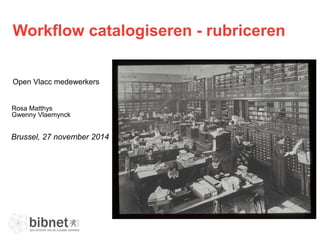


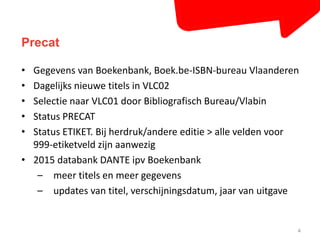
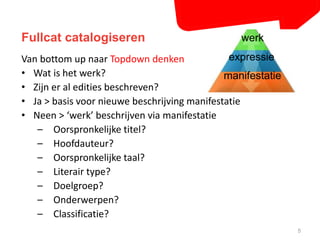

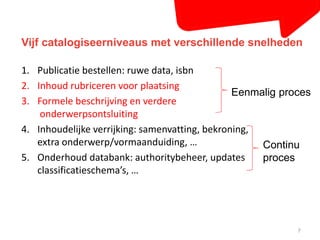
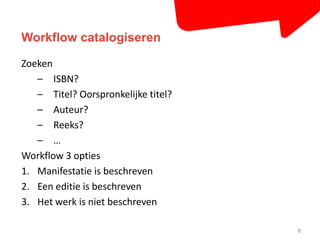
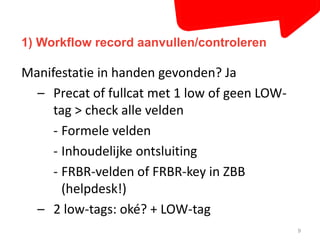




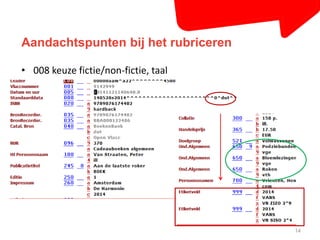

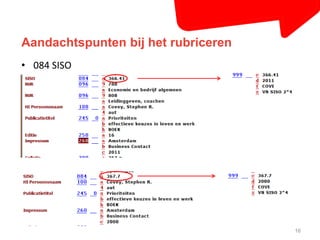



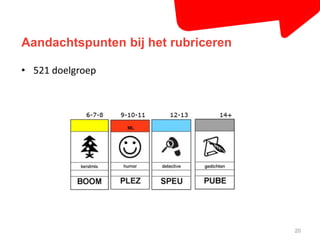


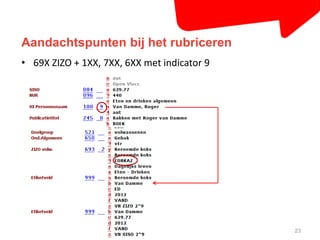
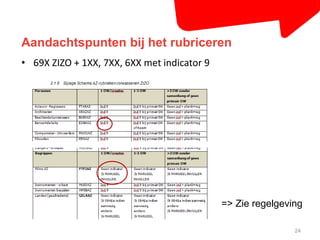
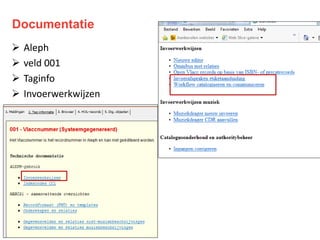
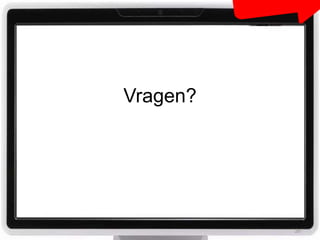
Ad
Recommended
Open Vlacc workflow catalogiseren en rubriceren
Open Vlacc workflow catalogiseren en rubricerenRosa Matthys
╠²
Presentatie voor Open Vlacc medewerkers 27/11/2014Catalografie Bibliotheekschool Gent 20151217
Catalografie Bibliotheekschool Gent 20151217Rosa Matthys
╠²
Nieuwe ontwikkelingen in catalografie voor openbare bibliotheken: FRBR in Aquabrowser, RDA en ViafFRBR in Aquabrowser Limburg 2015
FRBR in Aquabrowser Limburg 2015Rosa Matthys
╠²
Toelichting voor de Limburgse bibliotheken over het groeperen van zoekresultaten in AquabrowserDigital native 20151006
Digital native 20151006LOCUS
╠²
Inspirerende voorbeelden en mogelijkheden voor digitalisering in de cultuursector.Digileen Staten-Generaal klassiekemuziek
Digileen Staten-Generaal klassiekemuziekvcob
╠²
Presentatie op Staten-Generaal van klassieke muziek 1 december 2009 door Michiel Laan en Johan MijsBib Kalmthout - intensieve samenwerking met het OCMW en Digidak
Bib Kalmthout - intensieve samenwerking met het OCMW en DigidakBib Kalmthout
╠²
Opzetten van een duurzame e-inclusiesamenwerking tussen bib, OCMW en Digidak.
Pitch en praktijktafel tijdens studiedag "Aan de slag met kansengroepen" op 20 oktober 2015. Organisatie Mediawijs.bePraktische tips voor informatiebeheer
Praktische tips voor informatiebeheerJan Van Hee
╠²
║▌║▌▀Żs die ik gebruikte voor de workshop "praktische tips voor informatiebeheer" op de studiedag "Wat kan KIM (kennis- en informatiemanagement) voor je organisatie betekenen?" op donderdag 16 Oktober 2014. Organisatie: De Ambrassade, Forum voor Amateurkunsten en SociusCatalog entries of nonbook materials
Catalog entries of nonbook materialsIme Amor Mortel
╠²
This catalog entry summarizes 14 nonbook materials, including art reproductions, maps, charts, educational kits, films, filmstrips, flashcards, games, technical drawings, and videorecordings. For each item, it provides the title, creator/publisher, date, physical description, and subject terms.Systematisch zoeken in literatuurbronnen
Systematisch zoeken in literatuurbronnenBianca Kramer
╠²
Presentatie voor de Nederlandse Vereniging voor Allergologie (30 oktober 2010)Subject cataloging a review
Subject cataloging a reviewIme Amor Mortel
╠²
The document provides an overview of subject cataloging, including defining key terms, outlining principles and concepts, and reviewing the Sears List of Subject Headings and Library of Congress Subject Headings. It discusses assigning subject headings, subject analysis, types of subject catalogs, and principles of subject cataloging such as uniform and unique headings.Notes and Bibliography
Notes and BibliographyIme Amor Mortel
╠²
This document provides guidelines for creating bibliographic entries for various types of published works including books, periodicals, newspapers, reviews, and unpublished materials. It describes the standard elements included in bibliographic citations such as author, title, publisher, date, and page numbers. Examples are given for books with one author or multiple authors, edited volumes, reprints, and works published in journals, magazines, and newspapers.Classification a review
Classification a reviewIme Amor Mortel
╠²
The document provides an overview of library classification systems and processes, including definitions of key terms, principles of classification, descriptions of major classification schemes like Dewey Decimal and Library of Congress, and details on assigning call numbers, shelflisting, and filing catalog records. It compares features of different systems and outlines their strengths and weaknesses.Cataloging of nonbook materials edited
Cataloging of nonbook materials editedIme Amor Mortel
╠²
This document discusses the cataloging of nonbook materials, including definitions, categories, and descriptive cataloging. It outlines the sources of information, access points, areas of description, and rules for transcribing title, edition, publication, physical description, and other areas. Differences from book cataloging include additional material specific details areas and variations in physical description transcription depending on material type. Similarities include punctuation, main/added entries, subject headings, and transcription of some description areas.Gebruikersonderzoek in de bib van VSPW-Gent
Gebruikersonderzoek in de bib van VSPW-Gentemannaerts
╠²
Presentatie gemaakt in het kader van het vak Onderzoeks- en analysemethoden.
Verwerking van enquête gehouden in okt. 2009
GroepswerkIndexing
IndexingIme Amor Mortel
╠²
The document defines various terms related to indexing such as index, descriptor, document, identifier, indexing language, indexing system, keyword, qualifier, and translation. It then discusses the history and development of indexing from early civilizations to modern computerized indexing. It also covers different types of indexes like alphabetical, classified, concordance, and periodical indexes. Finally, it outlines principles of indexing like exhaustivity, specificity, consistency and different indexing languages and systems.Marc 21
Marc 21Soumen Mondal
╠²
The document discusses MARC 21 records, which are machine-readable cataloging records used to describe items in a library collection. A MARC record contains several fields identified by 3-digit tags, including fields for author, title, publication details, and subject headings. Fields like 245 contain title information, 260 contains publication details, and 650 contains subject headings. The document outlines many common MARC fields and their definitions.Web 3.0
Web 3.0Jo Bhakdi for Pioneerradio
╠²
The document discusses the evolution of the internet from Web 1.0 to Web 3.0. Web 1.0 consisted of traditional media companies pushing content to passive users, while Web 2.0 enabled user-generated content through platforms that allowed everyone to publish. However, very few people were able to earn a living from publishing on these platforms. Web 3.0 aims to enable user-generated business by providing everyone with professional publishing and business management tools to run their own media businesses and make a living from their creativity.Open vlacc context Vlaanderen
Open vlacc context Vlaanderen Bibnet vzw
╠²
Toelichting bij studiedag voor G6-vlaccmedewerkers. De gewijzigde Vlaamse context20070913 Delaur├®Johan
20070913 Delaur├®JohanVlaamse Vereniging voor Bibliotheek, Archief & Documentatie vzw (VVBAD)
╠²
Achter de schermen van Open VlaccStudiedag voor vlaccmedewerkers proeverij collectiemanagement en open vlacc
Studiedag voor vlaccmedewerkers proeverij collectiemanagement en open vlaccBibnet vzw
╠²
toelichting bij studiedag G6-medewerkers Open VlaccMore Related Content
Viewers also liked (16)
Bib Kalmthout - intensieve samenwerking met het OCMW en Digidak
Bib Kalmthout - intensieve samenwerking met het OCMW en DigidakBib Kalmthout
╠²
Opzetten van een duurzame e-inclusiesamenwerking tussen bib, OCMW en Digidak.
Pitch en praktijktafel tijdens studiedag "Aan de slag met kansengroepen" op 20 oktober 2015. Organisatie Mediawijs.bePraktische tips voor informatiebeheer
Praktische tips voor informatiebeheerJan Van Hee
╠²
║▌║▌▀Żs die ik gebruikte voor de workshop "praktische tips voor informatiebeheer" op de studiedag "Wat kan KIM (kennis- en informatiemanagement) voor je organisatie betekenen?" op donderdag 16 Oktober 2014. Organisatie: De Ambrassade, Forum voor Amateurkunsten en SociusCatalog entries of nonbook materials
Catalog entries of nonbook materialsIme Amor Mortel
╠²
This catalog entry summarizes 14 nonbook materials, including art reproductions, maps, charts, educational kits, films, filmstrips, flashcards, games, technical drawings, and videorecordings. For each item, it provides the title, creator/publisher, date, physical description, and subject terms.Systematisch zoeken in literatuurbronnen
Systematisch zoeken in literatuurbronnenBianca Kramer
╠²
Presentatie voor de Nederlandse Vereniging voor Allergologie (30 oktober 2010)Subject cataloging a review
Subject cataloging a reviewIme Amor Mortel
╠²
The document provides an overview of subject cataloging, including defining key terms, outlining principles and concepts, and reviewing the Sears List of Subject Headings and Library of Congress Subject Headings. It discusses assigning subject headings, subject analysis, types of subject catalogs, and principles of subject cataloging such as uniform and unique headings.Notes and Bibliography
Notes and BibliographyIme Amor Mortel
╠²
This document provides guidelines for creating bibliographic entries for various types of published works including books, periodicals, newspapers, reviews, and unpublished materials. It describes the standard elements included in bibliographic citations such as author, title, publisher, date, and page numbers. Examples are given for books with one author or multiple authors, edited volumes, reprints, and works published in journals, magazines, and newspapers.Classification a review
Classification a reviewIme Amor Mortel
╠²
The document provides an overview of library classification systems and processes, including definitions of key terms, principles of classification, descriptions of major classification schemes like Dewey Decimal and Library of Congress, and details on assigning call numbers, shelflisting, and filing catalog records. It compares features of different systems and outlines their strengths and weaknesses.Cataloging of nonbook materials edited
Cataloging of nonbook materials editedIme Amor Mortel
╠²
This document discusses the cataloging of nonbook materials, including definitions, categories, and descriptive cataloging. It outlines the sources of information, access points, areas of description, and rules for transcribing title, edition, publication, physical description, and other areas. Differences from book cataloging include additional material specific details areas and variations in physical description transcription depending on material type. Similarities include punctuation, main/added entries, subject headings, and transcription of some description areas.Gebruikersonderzoek in de bib van VSPW-Gent
Gebruikersonderzoek in de bib van VSPW-Gentemannaerts
╠²
Presentatie gemaakt in het kader van het vak Onderzoeks- en analysemethoden.
Verwerking van enquête gehouden in okt. 2009
GroepswerkIndexing
IndexingIme Amor Mortel
╠²
The document defines various terms related to indexing such as index, descriptor, document, identifier, indexing language, indexing system, keyword, qualifier, and translation. It then discusses the history and development of indexing from early civilizations to modern computerized indexing. It also covers different types of indexes like alphabetical, classified, concordance, and periodical indexes. Finally, it outlines principles of indexing like exhaustivity, specificity, consistency and different indexing languages and systems.Marc 21
Marc 21Soumen Mondal
╠²
The document discusses MARC 21 records, which are machine-readable cataloging records used to describe items in a library collection. A MARC record contains several fields identified by 3-digit tags, including fields for author, title, publication details, and subject headings. Fields like 245 contain title information, 260 contains publication details, and 650 contains subject headings. The document outlines many common MARC fields and their definitions.Web 3.0
Web 3.0Jo Bhakdi for Pioneerradio
╠²
The document discusses the evolution of the internet from Web 1.0 to Web 3.0. Web 1.0 consisted of traditional media companies pushing content to passive users, while Web 2.0 enabled user-generated content through platforms that allowed everyone to publish. However, very few people were able to earn a living from publishing on these platforms. Web 3.0 aims to enable user-generated business by providing everyone with professional publishing and business management tools to run their own media businesses and make a living from their creativity.Similar to Open Vlacc Workflow catalogiseren rubriceren (15)
Open vlacc context Vlaanderen
Open vlacc context Vlaanderen Bibnet vzw
╠²
Toelichting bij studiedag voor G6-vlaccmedewerkers. De gewijzigde Vlaamse context20070913 Delaur├®Johan
20070913 Delaur├®JohanVlaamse Vereniging voor Bibliotheek, Archief & Documentatie vzw (VVBAD)
╠²
Achter de schermen van Open VlaccStudiedag voor vlaccmedewerkers proeverij collectiemanagement en open vlacc
Studiedag voor vlaccmedewerkers proeverij collectiemanagement en open vlaccBibnet vzw
╠²
toelichting bij studiedag G6-medewerkers Open Vlacc20070914 Callewaert Rosemie
20070914 Callewaert RosemieVlaamse Vereniging voor Bibliotheek, Archief & Documentatie vzw (VVBAD)
╠²
FRBR: een praktijkvoorbeeld20070914 Callewaert Rosemie
20070914 Callewaert RosemieVlaamse Vereniging voor Bibliotheek, Archief & Documentatie vzw (VVBAD)
╠²
FRBR: een praktijkvoorbeeldMy Discoveries evaluatie 2015
My Discoveries evaluatie 2015Johan Mijs
╠²
Presentatie over de evaluatie van My Discoveries, een 8-jaar oude tool voor lijstjes, waarderingen, recensies en tags in AquaBrowser (TM) software, ter voorbereiding van de ontwikkeling van een nieuwe toepassing voor lijstjes in Mijn BibliotheekOpen vlacc helpdesk provincie limburg
Open vlacc helpdesk provincie limburgRosa Matthys
╠²
Toelichting bij het protocol Helpdesk Open Vlacc voor de Limburgse bibliothekenSvz geautomatiseerde aanmaak etiketten
Svz geautomatiseerde aanmaak etikettenLisbeth Vandoorne
╠²
Een stand van zaken van de ontwikkelingen in het kader van een geautomatiseerde aanmaak van rugetiketten voor bibliotheekmaterialen.
Op basis van de afspraken gemaakt met de werkgroep etiketten werd voor de boeken volwassenen een systeem geprogrammeerd dat het type etiket en de invulling bepaald kan worden op basis van het bibliografische record. Via een koppeling met biblioprint zal het in de toekomst mogelijk zijn etiketten te (laten) maken zonder zelf informatie te moeten intypen in biblioprint. Basisopleiding Aleph-gebruik Open Vlacc (Rosemie Callewaert)
Basisopleiding Aleph-gebruik Open Vlacc (Rosemie Callewaert)Rosemie Callewaert
╠²
Basisopleiding Aleph-gebruik aan Open Vlacc-invoerders september 200720070914 Callewaert Rosemie
20070914 Callewaert RosemieVlaamse Vereniging voor Bibliotheek, Archief & Documentatie vzw (VVBAD)
╠²
20070914 Callewaert Rosemie
20070914 Callewaert RosemieVlaamse Vereniging voor Bibliotheek, Archief & Documentatie vzw (VVBAD)
╠²
Ad
More from Bibnet vzw (20)
Mijn bibliotheek lijsten voor bibliotheken - december 2015
Mijn bibliotheek lijsten voor bibliotheken - december 2015Bibnet vzw
╠²
Wie zoekt in de catalogus weet meestal wat hij zoekt. Met de zoektaal kunnen we al een handje helpen. Maar hoe kunnen we inspireren met een selectie?
In Mijn Bibliotheek administratie kan je nu als bibliotheekmedewerker lijsten maken, beheren en delen. Je start hiervoor in de AquaBrowser catalogus waarbij je ├®├®n per ├®├®n je lijst kan samenstellen. Je kiest vervolgens of je je lijst met het publiek, in dit geval de andere bibliotheken, wil delen.
De lijstjesfunctionaliteit is voorlopig enkel toegankelijk voor bibliotheken via de Mijn Bibliotheek administratie en de bibliotheekmodus (librarian mode) van de AquaBrowser.
Handleiding: http://www.bibnet.be/portal/page/portal/D7441E1A17FA46EDA28782B7647A1B13 AquaBrowser versie 4.14 auteurspagina's
AquaBrowser versie 4.14 auteurspagina'sBibnet vzw
╠²
Wie een gerichte zoekvraag doet op auteur via de auteursindex krijgt bovenaan de bibliotheekcatalogus een foto te zien met een woordje uitleg. Deze informatie halen we uit Wikipedia. Een mooi voordeel van deze werkwijze is dat de informatie mee vertaald wordt nadat je een andere taal koos in de header.
In de achtergrond werd ook werk gemaakt van een standaardisering van de auteursnamen uit de verschillende bibliotheeksystemen.AquaBrowser versie 4.14 editiegroepering
AquaBrowser versie 4.14 editiegroeperingBibnet vzw
╠²
ŌĆ£Op de resultatenpagina willen we onmiddellijk kunnen zien in welk materiaal en welke taal het item is.ŌĆØ Het jaar van uitgave is vaak (maar niet altijd) minder relevant. ŌĆ£We willen van de verschillende jaren van uitgave op een scherm zien welke wel/niet binnen zijn. Is het meest recente er niet, dan kiezen we een ouder exemplaar.ŌĆØ
De verbeterde editiegroepering laat ons toe om items met dezelfde titel, auteur, materiaal en taal maar een ander uitgavejaar samen weer te geven op de resultatenpagina, detailpagina en het beschikbaarheidsscherm. Andere materialen en talen worden expliciet gesuggereerd op de resultaten- en detailpagina.
We cre├½erden ook drie nieuwe ŌĆśvirtueleŌĆÖ materialen: dwarsliggers, luisterboeken en Makkelijk Lezen. In de catalografie verandert hiervoor niets, de AquaBrowser zorgt voor de afhandeling.AquaBrowser versie 4.14 autocomplete
AquaBrowser versie 4.14 autocompleteBibnet vzw
╠²
Wie vaak Google gebruikt, kent het principe maar al te goed. Het gebruikersonderzoek leerde ons dat alle gebruikers deze zoeksuggesties verwachten terwijl ze typen. Hoog tijd dus om ook de bibliotheekcatalogus bij de tijd te brengen.
De AquaBrowser geeft je nu tijdens het typen suggesties wat je zou kunnen zoeken en wat populaire zoekresultaten zijn. Deze suggesties zijn gebaseerd op wat in jouw bibliotheek zit en wat het meest relevant is. E-boeken in de bib (IAZ 18 september 2015)
E-boeken in de bib (IAZ 18 september 2015)Bibnet vzw
╠²
In mei 2014 startte de Vlaamse bibliotheeksector het pilootproject ŌĆśE-boeken in de bibŌĆÖ. Twee derde van de bibliotheken namen deel. Tijd voor een grote round-up en bespreking van het vervolgtraject. Naar Eengemaakt Bibliotheeksysteem voor Vlaanderen (IAZ, 18 september 2015)
Naar Eengemaakt Bibliotheeksysteem voor Vlaanderen (IAZ, 18 september 2015)Bibnet vzw
╠²
Eind 2014 gaven Bibnet, de provincies en de VGC de opdracht voor een studie naar de technische, organisatorische en financiële haalbaarheid van een consolidatie van de bestaande provinciale bibliotheeksystemen in een eengemaakte Vlaams bibliotheeksysteem. De presentatie belicht de onderzoeksresultaten en het vervolgtraject. Mijn Bibliotheek nieuwe ontwikkelingen (IAZ, 18 september 2015)
Mijn Bibliotheek nieuwe ontwikkelingen (IAZ, 18 september 2015)Bibnet vzw
╠²
Wat begon met Open Bib ID, de centrale authenticatie- en autorisatieomgeving voor de Vlaamse bibliotheken is ondertussen uitgegroeid tot Mijn Bibliotheek, een volwaardige online self-service omgeving voor de Vlaamse bibliotheekgebruikers, met toegangsmogelijkheden tot digitale collecties en een rijke monitoringomgeving voor de bibliotheekprofessional. Het aantal deelnemende bibliotheken en gebruikers groeit gestaag. We geven een overzicht van de nieuwe functionaliteiten, in het bijzonder 'Mijn Lijsten'. Bibliotheekportalen nieuwe ontwikkelingen (IAZ, 18 september 2015)
Bibliotheekportalen nieuwe ontwikkelingen (IAZ, 18 september 2015)Bibnet vzw
╠²
In de loop van de voorbije jaren zijn tientallen nieuwe bibliotheken aangesloten op het project Bibliotheekportalen, waaronder voor het eerst ook een groot aantal bibliotheken die niet zijn aangesloten op het provinciaal bibliotheeksysteem. Ook in 2015 volgen er nog. Stilaan komt het einddoel van een Vlaamse centrale publiekscatalogus met verrijkte ontsluiting van de collecties van alle Vlaamse bibliotheken in zicht. Het project staat niet stil, maar evolueert constant. We geven jullie een kort overzicht van de ontwikkelingen van de laatste maanden en presenteren wat in de loop van het najaar zal worden uitgerold. Metadata is een netwerk v4
Metadata is een netwerk v4Bibnet vzw
╠²
Een blik achter de schermen van het bibliografische data-beheer in bibliotheekportalen. Ddd leuven demo mijn bibliotheek administratie 20141006
Ddd leuven demo mijn bibliotheek administratie 20141006Bibnet vzw
╠²
DDD2014, Leuven
Mijn Bibliotheek door Peter De KeyserDdd brugge demo mijn bibliotheek administratie 20141006
Ddd brugge demo mijn bibliotheek administratie 20141006Bibnet vzw
╠²
DDD Brugge 2014
Mijn Bibliotheek-administratie en rapportering
Peter De Keyser/ Johan MijsBibnet regionale ddd_blik_op_cultuur_slideshare
Bibnet regionale ddd_blik_op_cultuur_slideshareBibnet vzw
╠²
DDD Regio/ Discussie- en Doedag.
Aan de slag met de toolkit/ Cultuurnet - Davy De LaeterDDD Regio: demo Mijn Bibliotheek rapportering - Johan Mijs
DDD Regio: demo Mijn Bibliotheek rapportering - Johan MijsBibnet vzw
╠²
DDD regio: Gent, Hasselt, Antwerpen, Brugge en Leuven
Onderdeel Mijn Bibliotheek: rapportering - Johan MijsLezing Koen Vandendriessche Denk- en Discussiedag 2014
Lezing Koen Vandendriessche Denk- en Discussiedag 2014Bibnet vzw
╠²
Lezing Koen Vandendriessche Denk- en Discussiedag 2014
Traject innovatieInleiding Jan Braeckman en Johan Mijs Denk- en Discussiedag 2014
Inleiding Jan Braeckman en Johan Mijs Denk- en Discussiedag 2014Bibnet vzw
╠²
Introductie Jan Braeckman en Johan Mijs Denk- en Discussiedag 2014.Denk- en Discussiedag 2014 Lezing Frank Daniel
Denk- en Discussiedag 2014 Lezing Frank DanielBibnet vzw
╠²
This document summarizes a presentation on e-book lending through public libraries in Germany. It discusses the growth of e-book lending since 2007 through a centralized service. Key points include how the service works by negotiating licenses with publishers and allowing patrons to download digital files for a limited time. Challenges addressed are limited formats, devices, and loan periods supported as well as the need for improved technology integration. The presentation also reviews promotion efforts and the future outlook, hoping for new license models, easier technology, and more compatibility.Presentatie Denk- en Discussiedag 16/09/2014 Lezing Anne Vrints
Presentatie Denk- en Discussiedag 16/09/2014 Lezing Anne VrintsBibnet vzw
╠²
Lezing Anne Vrints
Denk- en Discussiedag 2014
Brussel, Bozar
Bibnet
Thema: publiekswerkingSociale media. Are you connected?
Sociale media. Are you connected?Bibnet vzw
╠²
Introductie sociale media.
Welke kanalen? Hoe pak je het aan? Welke strategieën gebruik je? Waarom zou je sociale media gebruiken?Ad
Recently uploaded (13)
The Ongoing Technological System Ait El Hadj Smal
The Ongoing Technological System Ait El Hadj Smalbhfekrzdq718
╠²
The Ongoing Technological System Ait El Hadj Smal
The Ongoing Technological System Ait El Hadj Smal
The Ongoing Technological System Ait El Hadj SmalThe Psychology of Spine Surgery 1st Edition Andrew R. Block
The Psychology of Spine Surgery 1st Edition Andrew R. Blockugcrokz061
╠²
The Psychology of Spine Surgery 1st Edition Andrew R. Block
The Psychology of Spine Surgery 1st Edition Andrew R. Block
The Psychology of Spine Surgery 1st Edition Andrew R. BlockConcepts in Strategic Management and Business Policy Globalization Innovation...
Concepts in Strategic Management and Business Policy Globalization Innovation...ewlalgp855
╠²
Concepts in Strategic Management and Business Policy Globalization Innovation and Sustainability 15th Edition Wheelen Solutions Manual
Concepts in Strategic Management and Business Policy Globalization Innovation and Sustainability 15th Edition Wheelen Solutions Manual
Concepts in Strategic Management and Business Policy Globalization Innovation and Sustainability 15th Edition Wheelen Solutions ManualThe Keys to Effective Schools Educational Reform as Continuous Improvement 2n...
The Keys to Effective Schools Educational Reform as Continuous Improvement 2n...xkedklr8745
╠²
The Keys to Effective Schools Educational Reform as Continuous Improvement 2nd Edition Willis D. Hawley
The Keys to Effective Schools Educational Reform as Continuous Improvement 2nd Edition Willis D. Hawley
The Keys to Effective Schools Educational Reform as Continuous Improvement 2nd Edition Willis D. HawleyComparative Genomics Methods And Protocols 1st Edition Joo C Setubal
Comparative Genomics Methods And Protocols 1st Edition Joo C Setubalxbhamef758
╠²
Comparative Genomics Methods And Protocols 1st Edition Joo C Setubal
Comparative Genomics Methods And Protocols 1st Edition Joo C Setubal
Comparative Genomics Methods And Protocols 1st Edition Joo C SetubalRECENT DEVELOPMENTS IN BIOENERGY RESEARCH Vijai G. Gupta (Editor)
RECENT DEVELOPMENTS IN BIOENERGY RESEARCH Vijai G. Gupta (Editor)hsakvtrw562
╠²
RECENT DEVELOPMENTS IN BIOENERGY RESEARCH Vijai G. Gupta (Editor)
RECENT DEVELOPMENTS IN BIOENERGY RESEARCH Vijai G. Gupta (Editor)
RECENT DEVELOPMENTS IN BIOENERGY RESEARCH Vijai G. Gupta (Editor)Plague Deadly Diseases And Epidemics 2nd Edition 2nd Edition Donald Emmeluth
Plague Deadly Diseases And Epidemics 2nd Edition 2nd Edition Donald Emmeluthiimxnbifh5704
╠²
Plague Deadly Diseases And Epidemics 2nd Edition 2nd Edition Donald Emmeluth
Plague Deadly Diseases And Epidemics 2nd Edition 2nd Edition Donald Emmeluth
Plague Deadly Diseases And Epidemics 2nd Edition 2nd Edition Donald EmmeluthReintegrating Iran With The West Challenges And Opportunities Mohammad N Elahee
Reintegrating Iran With The West Challenges And Opportunities Mohammad N Elaheegessmiorsan29
╠²
Reintegrating Iran With The West Challenges And Opportunities Mohammad N Elahee
Reintegrating Iran With The West Challenges And Opportunities Mohammad N Elahee
Reintegrating Iran With The West Challenges And Opportunities Mohammad N ElaheeTime and Decision Economic and Psychological Perspectives of Intertemporal Ch...
Time and Decision Economic and Psychological Perspectives of Intertemporal Ch...gjbdnmt4858
╠²
Time and Decision Economic and Psychological Perspectives of Intertemporal Choice George Loewenstein
Time and Decision Economic and Psychological Perspectives of Intertemporal Choice George Loewenstein
Time and Decision Economic and Psychological Perspectives of Intertemporal Choice George LoewensteinMeteorology Today 11th Edition Ahrens Solutions Manual
Meteorology Today 11th Edition Ahrens Solutions Manualsndbeuvu3032
╠²
Meteorology Today 11th Edition Ahrens Solutions Manual
Meteorology Today 11th Edition Ahrens Solutions Manual
Meteorology Today 11th Edition Ahrens Solutions ManualA New Architecture For Functional Grammar Functional Grammar Series J Lachlan...
A New Architecture For Functional Grammar Functional Grammar Series J Lachlan...ecnlxfkyv5483
╠²
A New Architecture For Functional Grammar Functional Grammar Series J Lachlan Mackenzie
A New Architecture For Functional Grammar Functional Grammar Series J Lachlan Mackenzie
A New Architecture For Functional Grammar Functional Grammar Series J Lachlan MackenzieUnderstanding Social Psychology Across Cultures Engaging With Others In A Cha...
Understanding Social Psychology Across Cultures Engaging With Others In A Cha...ivaqaxwwi7869
╠²
Understanding Social Psychology Across Cultures Engaging With Others In A Changing World Second Peter B Smith
Understanding Social Psychology Across Cultures Engaging With Others In A Changing World Second Peter B Smith
Understanding Social Psychology Across Cultures Engaging With Others In A Changing World Second Peter B SmithActivity Based Intelligence Principles and Applications Patrick Biltgen
Activity Based Intelligence Principles and Applications Patrick Biltgenltdmupw2531
╠²
Activity Based Intelligence Principles and Applications Patrick Biltgen
Activity Based Intelligence Principles and Applications Patrick Biltgen
Activity Based Intelligence Principles and Applications Patrick BiltgenOpen Vlacc Workflow catalogiseren rubriceren
- 1. Workflow catalogiseren - rubriceren Open Vlacc medewerkers Rosa Matthys Gwenny Vlaemynck Brussel, 27 november 2014
- 2. Doel van de afspraken ŌĆó Verhogen effici├½ntie ŌĆó Verhogen consistentie ŌĆó Verhogen snelheid 2
- 3. Waarom ? Open Vlacc is bibliografisch bestand voor ŌĆó Copycataloging naar provinciale of lokale database ŌĆó Presentatie aan publiek ŌĆó Collectieverwerking (standaardetiket) ŌĆó Bestelproces 3
- 4. Precat ŌĆó Gegevens van Boekenbank, Boek.be-ISBN-bureau Vlaanderen ŌĆó Dagelijks nieuwe titels in VLC02 ŌĆó Selectie naar VLC01 door Bibliografisch Bureau/Vlabin ŌĆó Status PRECAT ŌĆó Status ETIKET. Bij herdruk/andere editie > alle velden voor 999-etiketveld zijn aanwezig ŌĆó 2015 databank DANTE ipv Boekenbank ŌĆō meer titels en meer gegevens ŌĆō updates van titel, verschijningsdatum, jaar van uitgave 4
- 5. Fullcat catalogiseren 5 expressie Van bottom up naar Topdown denken ŌĆó Wat is het werk? ŌĆó Zijn er al edities beschreven? ŌĆó Ja > basis voor nieuwe beschrijving manifestatie ŌĆó Neen > ŌĆśwerkŌĆÖ beschrijven via manifestatie ŌĆō Oorspronkelijke titel? ŌĆō Hoofdauteur? ŌĆō Oorspronkelijke taal? ŌĆō Literair type? ŌĆō Doelgroep? ŌĆō Onderwerpen? ŌĆō Classificatie? werk manifestatie
- 6. Belang 1ste LOW-tag bibliotheek ŌĆó 1ste LOW-tag = 1ste bib die beschrijft op basis van publicatie ŌĆó 1 bib beschrijft het ŌĆ£werkŌĆØ = basis voor alle volgende edities/manifestaties ŌĆó De tweede bib controleert / vult aan ŌĆó De volgende bibliotheken voegen LOW-tag toe ŌĆó Aandachtspunten 6 ’āś Precat met onderwerpsontsluiting (op basis van andere edities in Vlacc) ’āś Fullcat zonder LOW-tags ’ā×kunnen zondermeer aangepast worden, tenzij er meerdere edities in Open Vlacc zijn
- 7. Vijf catalogiseerniveaus met verschillende snelheden 1. Publicatie bestellen: ruwe data, isbn 2. Inhoud rubriceren voor plaatsing 3. Formele beschrijving en verdere onderwerpsontsluiting 4. Inhoudelijke verrijking: samenvatting, bekroning, extra onderwerp/vormaanduiding, ŌĆ” 5. Onderhoud databank: authoritybeheer, updates classificatieschemaŌĆÖs, ŌĆ” Eenmalig proces Continu proces 7
- 8. Workflow catalogiseren 8 Zoeken ŌĆō ISBN? ŌĆō Titel? Oorspronkelijke titel? ŌĆō Auteur? ŌĆō Reeks? ŌĆō ŌĆ” Workflow 3 opties 1. Manifestatie is beschreven 2. Een editie is beschreven 3. Het werk is niet beschreven
- 9. 1) Workflow record aanvullen/controleren 9 Manifestatie in handen gevonden? Ja ŌĆō Precat of fullcat met 1 low of geen LOW-tag > check alle velden - Formele velden - Inhoudelijke ontsluiting - FRBR-velden of FRBR-key in ZBB (helpdesk!) ŌĆō 2 low-tags: ok├®? + LOW-tag
- 10. 2) Workflow nieuwe editie catalogiseren 10 Geen manifestatie gevonden? Andere expressie/manifestatie gevonden? ja ŌĆō Check FRBR-velden of FRBR-key in ZBB (helpdesk!) ŌĆō Aleph record editor: Split screen ŌĆō Haal 1 record over ŌĆō Op 2de scherm > template openen ŌĆō Kopieer de attributen van het ŌĆśwerkŌĆÖ naar template ŌĆō Vul aan met attributen van expressie en manifestatie
- 11. 3) Workflow nieuw werk catalogiseren 11 Noteer ISBN Check VLC02: Alt+Z (Nederlandstalig werk) Gevonden? Niet gevonden? Selecteer record Expandeer naar template Ctrl+E Ontsluit het ŌĆśwerkŌĆÖ en vervolledig de beschrijving formeel en inhoudelijk Ontsluit het ŌĆśwerkŌĆÖ en vervolledig de beschrijving formeel en inhoudelijk
- 12. Rubriceren 12 Wat is rubriceren? Toekennen van alle velden die de plaats bepalen van een publicatie binnen een collectie. Een juiste rubricering is o.a. belangrijk voor de creatie van het etiketveld 999
- 13. Etiketveld 999 13 Etiketveld 999 voor: ŌĆó Volwassenen fictie: boek + audio ŌĆó Volwassenen non-fictie: boek + audio ŌĆó Jeugd fictie: 0-14 jaar ŌĆó Jeugd non-fictie: 0-5 jaar ŌĆó Jeugd non-fictie: 6-14 jaar > 2015 (Nog) geen etiketveld voor: ŌĆó Stripverhalen ŌĆó Dvd-video ŌĆó muziek
- 14. Aandachtspunten bij het rubriceren 14 ŌĆó 008 keuze fictie/non-fictie, taal
- 15. Aandachtspunten bij het rubriceren 15 ŌĆó 008 keuze fictie/non-fictie, taal
- 16. Aandachtspunten bij het rubriceren 16 ŌĆó 084 SISO
- 17. Aandachtspunten bij het rubriceren 17 ŌĆó 090 AVI
- 18. Aandachtspunten bij het rubriceren 18 ŌĆó 100/110 of 245|a als hoofdwoord
- 19. Aandachtspunten bij het rubriceren 19 ŌĆó 490 reeksveld met indicator 9 Wel indicator 9 Geen indicator 9
- 20. Aandachtspunten bij het rubriceren 20 ŌĆó 521 doelgroep
- 21. Aandachtspunten bij het rubriceren ŌĆó 650 genre met indicator 9 + 650 vormgenre Makkelijk lezen en 21 Groteletterboeken
- 22. Aandachtspunten bij het rubriceren ŌĆó 650 genre met indicator 9 + 650 vormgenre Makkelijk lezen en 22 Groteletterboeken => Zie regelgeving
- 23. Aandachtspunten bij het rubriceren 23 ŌĆó 69X ZIZO + 1XX, 7XX, 6XX met indicator 9
- 24. Aandachtspunten bij het rubriceren 24 ŌĆó 69X ZIZO + 1XX, 7XX, 6XX met indicator 9 => Zie regelgeving
- 25. Documentatie ’āś Aleph ’āś veld 001 ’āś Taginfo ’āś Invoerwerkwijzen
- 26. 26 Vragen?
Editor's Notes
- #6: Tot vandaag catalogiseren we meestal bottom up, we zoeken of het isbn aanwezig is, is dit niet het geval dan beschrijven de manifestatie, noteren de attributen/kenmerken van de manifestatie. Bijna op het einde van de beschrijving noteren we de oorspronkelijke titel. Bij bottom up denken, bekijken we ook het ŌĆ£werkŌĆØ, We zoeken uiteraard eerst of de manifestatie/isbn aanwezig is? Neen, dan is de volgende stap zoeken of het werk aanwezig is? Zijn er al edities beschreven, in andere talen? Andere vorm? Ja, dan is dat de basis voor de nieuwe beschrijvingen Neen, dan beschrijven we het ŌĆśwerkŌĆÖ + manifestatie/expressie in handen Dan bepalen we de Oorspr. titel Hoofdauteur Literair type Doelgroep Onderwerpen classificatie
